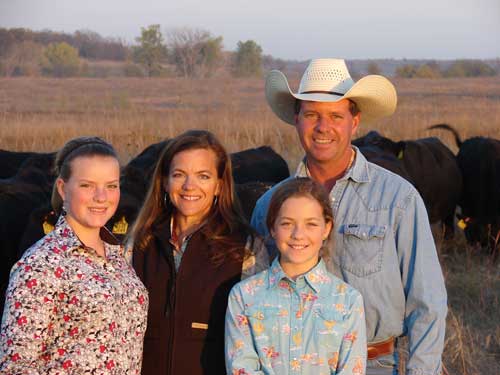The cattle industry is guardedly optimistic, and beef steak lovers should be happy, too.
Despite concerns about drought, high inputs and government intrusion, that was the analysis after the Kniebel Cattle Company/Downey Ranch, Inc., beef cattle seed stock production sale Friday southeast of Manhattan.
“We were really nervous going into the sale, with all of the negatives facing our business,” admitted Barb Downey of the Downey Ranch Angus operation at Wamego.

“However, record prices were paid in every division of the sale,” she related.
“Cattlemen are concerned about the dilemmas facing their industry, but most aren’t in panic mode yet,” Downey evaluated.
“Even with the drought, calf prices have remained very good. In addition, a lot of cow-calf operators also are farmers who have seen high grain prices,” she continued.
“Cowmen have planned and allotted their financial resources to invest in quality breeding stock, so when rains do come, they’ll be prepared for profitable opportunities producing calves,” Downey analyzed.
Then, she clarified, “The nation’s cow herd size has been sharply reduced, and is continuing down. When weather conditions break, there should be high demand for replacement females to increase that number.”
Their tenth annual sale saw Downey’s 42 black Angus bulls sell for a record $4,300 average, compared to $3,825 a year ago.
Kniebel Cattle Company at White City sold 29 Red Angus bulls for an all-time-high $5,000 apiece, up from $4,200, two years earlier.
High individually-priced lots can sometimes distort averages, so Downey was emphatic in pointing out that there was a $6,500 top black bull, and an $8,900 top red bull, with “prices quite consistent” throughout the auction.
A record 100 registered bidders from as far as away as Florida, Kentucky, South Dakota and Kansas’ neighboring states contended for the seed stock . However, Downey emphasized, “Majority of the cattle sold quite locally in surrounding counties.
“Many of the buyers were again our neighbors. More than 85 percent of the cattle went to repeat customers, which is extremely gratifying,” she appreciated.
Bred heifers have been a unique attraction for the Kniebel/Downey sale and saw record prices as well.
Sixty bred commercial heifers sold for a new high average of $1,880, compared to $1,700 in 2011. These included 30 Angus and Angus cross females from Downey, and 30 Red Angus and red and black baldies from Kniebel.
“We hadn’t ever set a base-bid before, but due to our concerns about drought conditions, we floored the heifers at $1,500 this year,” Downey admitted. “These are valuable females, and we’d be happy to keep them ourselves. Therefore, we set a reasonable base.”
Nationwide completely unique to the Kniebel/Downey female offering is that the breeders will keep the bred heifers, calve them out, and purchasers pick up the pairs at grass time, if that service is purchased.
“We have an exclusive live calf guarantee, so the buyers have no risk whatsoever,” Downey noted. “Even with our higher inputs, we held the cost for this service at last year’s levels.”
This assistance is especially appealing to those who don’t have the facilities, feed sources, essential-time-requirements, or even knowledge-capabilities for birthing first-calf-heifers.
“Buyers of two-thirds of the bred-females sold this year took advantage of our calve-out opportunity,” Downey commented. “I even had one cowman who has 500 cows ask me if I’d calve-out his whole herd for that price. I said, ‘No thanks.’”
Contending she doesn’t “have a crystal ball,” Downey recognized that cattle prices now are comparatively at all-time high levels. “It has been reflected some in consumer-buyer-resistance.
“So, I really don’t see how over-the-counter beef prices can continue higher, without hindering demand. However, if rains moderate the feed grain and forage markets, that will bring break-evens lower and help ease pressure on beef prices.
“There’ll continue to be strong demand for cattle, but ideally, lower inputs should help balance it out, so beef prices don’t increase,” Downey hopes.